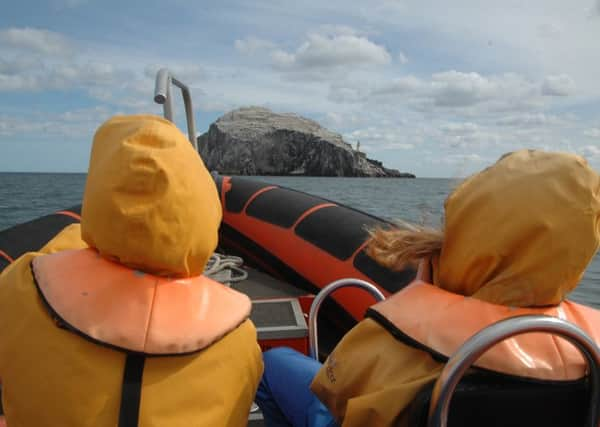Boat tour gives peerless view of bird life


In my more romantic moments, I have wondered what it would be like to be a figurehead on the prow of a ship. What an adventure, skimming across oceans, with salt spray in my face. Maybe I’ll get a little sense of the experience today as it’s the start of North Berwick’s Seabird Centre’s boat season and I’m off with my family to enjoy a Seabird Safari.
We are hoping to see plenty of birds on this safari which takes in three islands; the Lamb, Craigleith and the Bass Rock. Lasting for about an hour and a half, there is even time for a quick look along the historic East Lothian coastline, onboard our vessel, a rapid 12-seat RIB or rigid inflatable boat.
Advertisement
Hide AdWaterproofs and life jackets are donned and we listen to the all important safety briefing. We arrange ourselves astride the seats like a horse, as if it’s particularly choppy you sort of take the strain with your legs. Thankfully blue skies mean calm seas, and before we know it we are upon Lamb.
Uri Geller owns the island. It’s understood he purchased this uninhabitable volcanic outcrop in the Firth of Forth, because of its position on mystical ley-lines and its ancient history. It certainly seems to be a paradise for the birdlife which lives here. We glimpse guillemots galore, razorbills, kittiwakes and cormorants and even outrun a couple of eider ducks. Circling the entire island, we can clearly see its basalt towers.
Next up is Craigleith, which has links to Robert Louis Stevenson, who used to play on the beach overlooking it as a child. Another island nearby, Fidra is alleged to be his inspiration for the novel, Treasure Island. Everyone loves spotting puffins with their comical clown faces and their distinctive flappy flying style. James our guide fine-tunes our bird identifying skills, helping us differentiate between cormorants and shags. He makes us laugh with tales of the navigationally naïve junior pufflings which when fledging often end up on North Berwick high street, rather than in the North Sea. They have to be rounded up and re-released. Puffin numbers are increasing following the removal of the tree mallow weed, which was covering the birds’ burrows, and reducing the number of landing sites available to them.
We must have got our sea legs zooming over to the inhospitable Bass Rock as my daughters both stretch their arms out like wings. Here we have a closer look at gannets, those distinctive white birds with yellow ochre heads, black-tipped wings, long bills and piercing blue eyes. They lay single eggs, and like to hang out together in vast colonies to nest and raise their young. They have a wingspan of 180cm and can live for up to 35 years. Following a painstaking count by experts, involving the scouring of occupied nest sites from aerial photographs, this guano-covered rocky outcrop has been declared the world’s largest colony of northern gannets. It is home to more than 150,000 birds at the height of the breeding season. Watching them soar overhead is mesmerising, and the noise and smell is overpowering. David Attenborough is a big fan having filmed here. We spot a grey seal bobbing about near the mouth of a cave before we head off to examine the penthouse suite nest sites at the other side of the rock.
We move closer to the East Lothian coastline to look at Tantallon Castle, perched on a cliff top with its red sandstone curtain defence wall. It looks impressive, even in its current ruinous state. Built in the 1350s it must have been awe-inspiring in the heyday of the Douglases. On the next rocky outcrop headland, Ginhead, you can see the remains of an unimposing modern building. However, we learn it played a vital role during the Second World War as radar research carried out there was critical to the success of the D-Day landings.
Our fabulous day on the ocean waves was rounded off with lunch at the Seabird Cafe. Locally sourced fish and chips were the natural choice. My two hungry gannets certainly cleared their plates.
Advertisement
Hide AdThe Seabird Centre Three Island Seabird Safari costs £25 for adults. There is a minimum age limit for children of 7 years and a child’s ticket costs £18, www.seabird.org
Bookings can be made in person at the Seabird Centre booking office at North Berwick harbour or 01620 890202 for telephone bookings but a £3 surcharge applies.